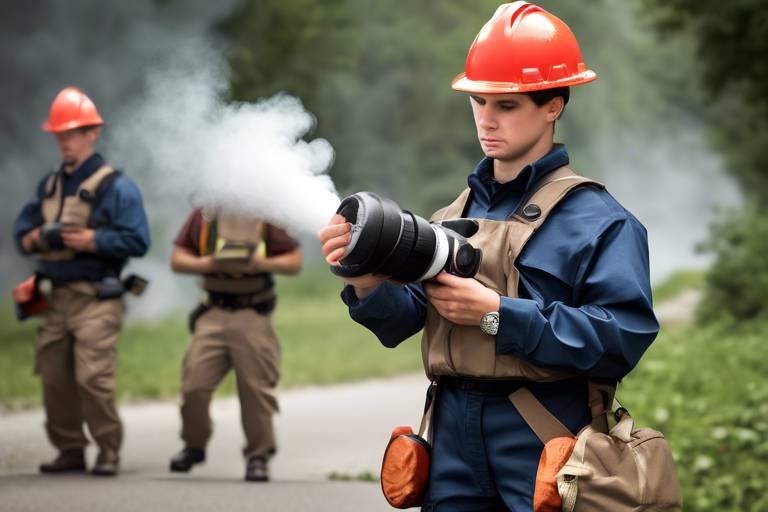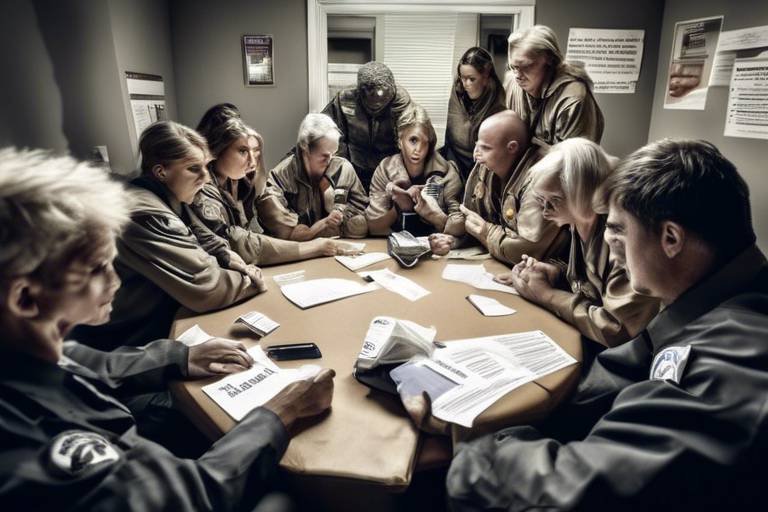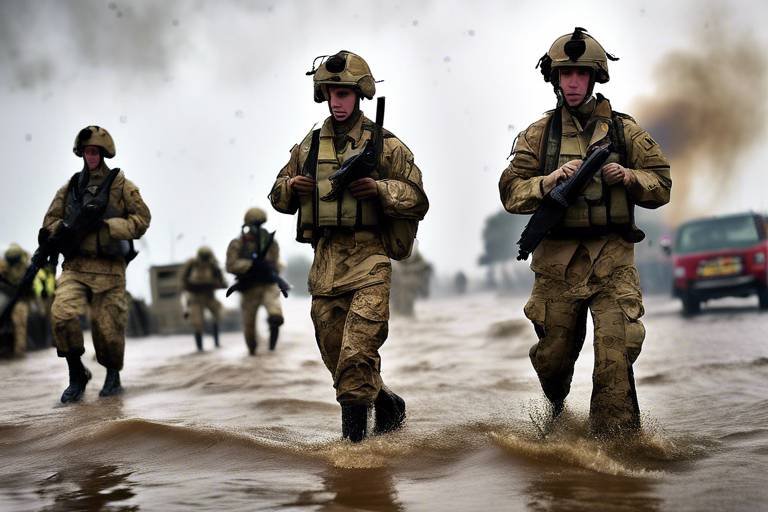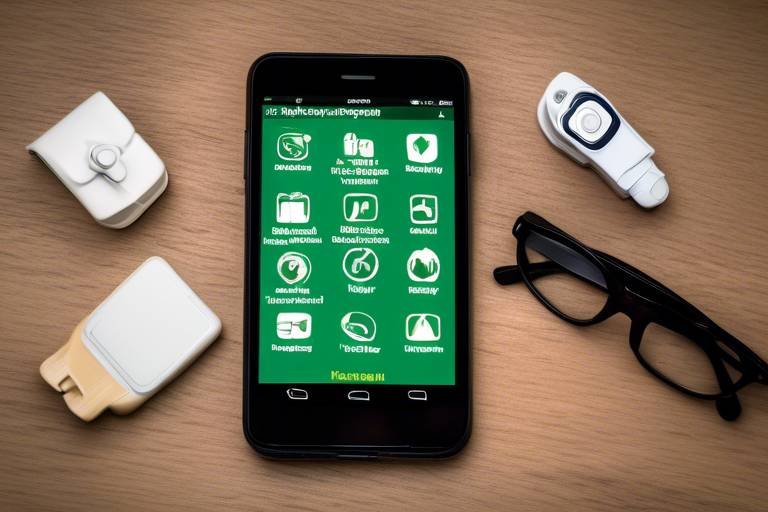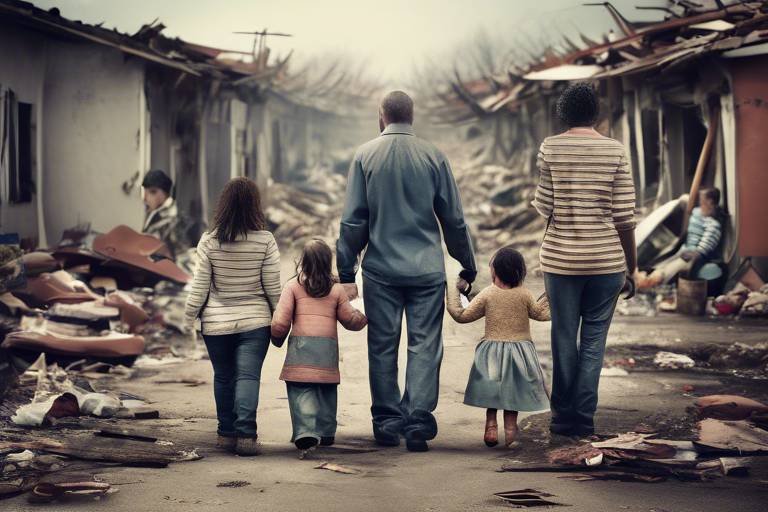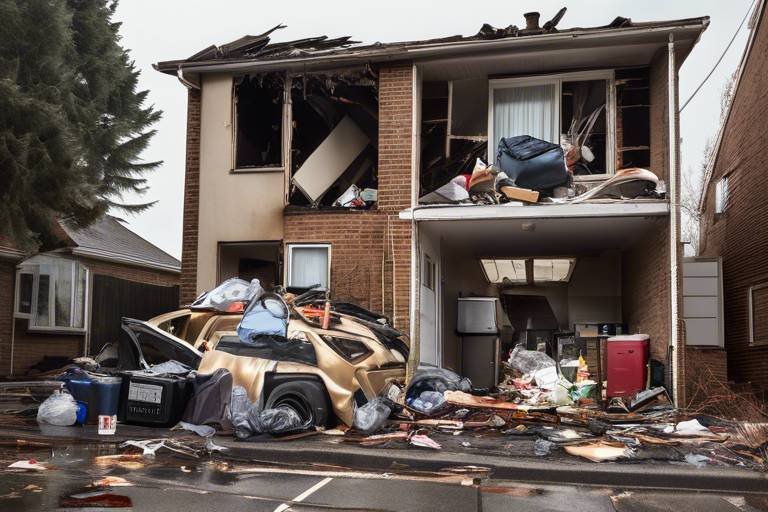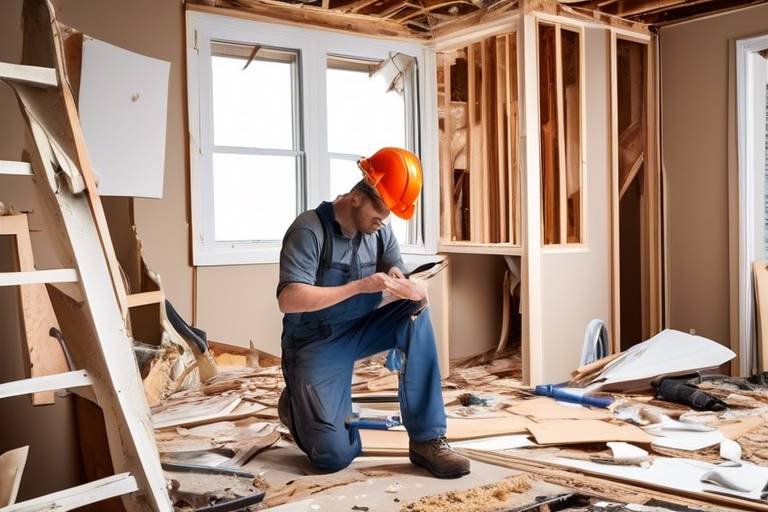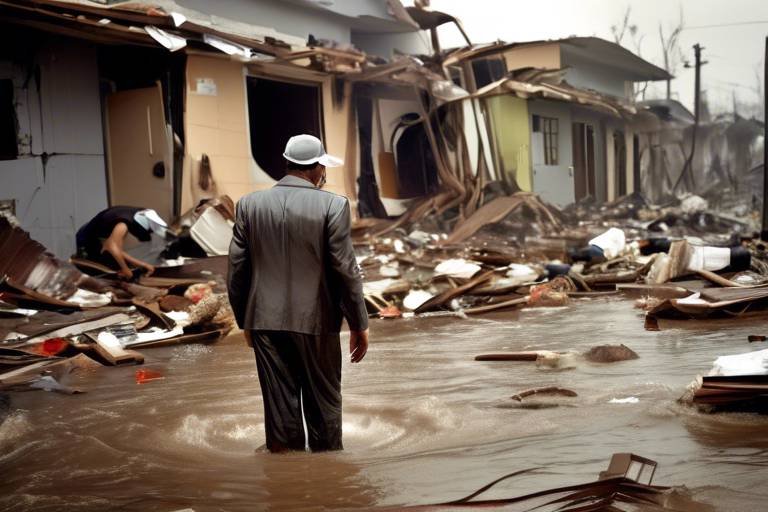How to Talk to Children about Disasters
When it comes to discussing the tough topic of disasters with children, it's essential to approach the conversation with both sensitivity and clarity. Children, unlike adults, often have a unique way of interpreting the world around them. They may not fully grasp the complexities of a disaster, but they certainly can pick up on the emotions and tensions in their environment. This can lead to confusion, fear, and anxiety. Therefore, we must equip ourselves with the right tools and strategies to ensure these discussions are both effective and comforting. In this article, we'll explore various ways to communicate about disasters, from understanding children's perspectives to providing reassurance and discussing safety measures.
Children perceive disasters differently than adults. Their understanding is often shaped by their developmental stage, previous experiences, and the information they receive from the media or adults. For instance, a younger child might see a news report about a hurricane and think it’s a game, while an older child may comprehend the seriousness but feel overwhelmed by fear. Understanding where your child is coming from is crucial. It allows you to tailor your conversations to address their specific fears and concerns while providing the necessary reassurance and clarity about the situation. Remember, it’s not just about what you say, but how you say it. A comforting tone and open body language can make a world of difference.
Timing is everything when discussing disasters with children. You wouldn’t want to spring such a heavy topic on them during a chaotic moment or when they’re preoccupied with something else. Instead, look for quiet moments when they seem receptive and open to conversation. This could be during a calm evening at home or while engaging in a relaxing activity. By choosing the right time, you create a safe space for dialogue, allowing your child to express their feelings and thoughts freely. A well-timed conversation can lead to a more impactful and meaningful dialogue, where children feel heard and understood.
When talking to children, it’s essential to use language they can grasp. Adjusting your vocabulary based on their age helps convey messages clearly, preventing confusion and fostering a sense of security. For younger children, simple and straightforward language works best. You might say, “Sometimes big storms happen, but we have safe places to go.” For older children, you can provide more detailed explanations, discussing the science behind disasters or the steps taken by emergency services. The key is to keep the conversation age-appropriate, ensuring they understand without feeling overwhelmed.
Children are naturally curious, and inviting them to ask questions promotes open communication. When they feel comfortable asking questions, it shows they are processing the information and trying to make sense of it all. Be prepared to answer their inquiries honestly; this not only alleviates fears but also validates their feelings. For example, if they ask, “Will a tornado come to our house?” you can reassure them by explaining the safety measures in place. This helps them process the information about the disaster more effectively and gives them a sense of control over their fears.
During uncertain times, children need reassurance. It’s crucial to emphasize safety measures and the support available from caregivers. Let them know that they are not alone in facing these challenges. Share what steps you are taking to keep them safe and how you will all work together as a family. For instance, you might say, “If there’s ever a storm, we will go to our safe spot together.” Such affirmations can significantly reduce anxiety and foster resilience in the face of disasters.
Explaining safety protocols can empower children. Teaching them about preparedness and what to do in emergencies instills confidence and a sense of control. You could create a simple safety plan together, which includes identifying safe spots in your home, discussing emergency contacts, and even practicing drills. This proactive approach not only equips them with knowledge but also makes them feel more secure. When children know what to do in case of a disaster, they are less likely to panic and more likely to respond calmly.
Various resources, such as books and videos, can aid discussions about disasters. These tools can help illustrate concepts and provide comfort, making it easier for children to grasp complex ideas in a relatable manner. Look for age-appropriate materials that explain disasters in a way that is engaging yet informative. For instance, there are excellent children's books that depict characters facing natural disasters and overcoming their fears. Such resources can serve as a springboard for discussion and help normalize their feelings.
After initial conversations, it’s important to follow up with children. Checking in on their feelings and thoughts reinforces support, allowing for ongoing dialogue. You might ask them, “How are you feeling about what we talked about?” This not only shows them that you care but also opens the door for any new questions or concerns they might have. Continuous communication is key to helping them process their emotions and feel safe.
- How do I know if my child understands the disaster? Look for cues in their behavior and questions. If they seem anxious or ask specific questions, they may need more reassurance or information.
- What if my child is too scared to talk? Give them time and space. Sometimes, children express themselves better through drawing or play, so encourage those activities.
- Should I avoid discussing disasters altogether? Not at all. Open conversations can help children feel more secure and prepared, but ensure you approach the topic with sensitivity.

Understanding Children's Perspectives
When it comes to discussing disasters, it’s essential to recognize that children perceive situations differently than adults. Their understanding of the world is shaped by their experiences, maturity level, and emotional development. For instance, while an adult might grasp the broader implications of a natural disaster, a child may only focus on the immediate feelings of fear or confusion it evokes. This difference in perspective is crucial when we approach conversations about such serious topics.
Children often interpret events through a lens of imagination and emotion. For example, they might think that a storm is a monster coming to get them, or that an earthquake means the ground is angry. This imaginative thinking can lead to heightened fears, making it imperative for us, as caregivers, to validate their feelings while providing clarity. Acknowledging that their fears are real, even if they seem exaggerated to us, helps them feel understood. It’s like reassuring a friend who’s scared of the dark; sometimes, they just need someone to hold their hand and say, “It’s okay to feel this way.”
Moreover, children’s cognitive abilities vary significantly with age. Younger children, for instance, may not fully understand the concept of time, leading them to believe that disasters could happen at any moment. In contrast, older children might be more aware of the news and the world around them, which could lead to increased anxiety. To effectively communicate with them, we must tailor our approach based on their age and comprehension level. Here’s a quick breakdown:
| Age Group | Understanding | Communication Tips |
|---|---|---|
| 3-5 years | Limited understanding; may see events as personal threats. | Use simple language; focus on feelings. |
| 6-8 years | Begin to understand cause and effect; may have fears based on media. | Encourage questions; provide clear, honest answers. |
| 9-12 years | More logical thinking; can grasp broader implications. | Discuss safety measures; involve them in planning. |
| 13+ years | Abstract thinking; aware of global issues. | Encourage critical thinking; discuss emotional responses. |
By understanding these developmental stages, we can better tailor our conversations to resonate with children’s unique perspectives. It’s like trying to tune a musical instrument; if you don’t adjust it to the right pitch, the music won’t sound right. Similarly, if we don’t adjust our communication style, we risk missing the mark entirely.
Ultimately, by fostering an environment where children feel safe to express their thoughts and feelings, we can help them navigate their fears and build resilience. Remember, the goal is not just to inform them about the disaster but to help them process their emotions and feel supported in times of uncertainty. So, let’s take that extra step to understand how they see the world, and in doing so, we can guide them through even the stormiest of times.

Choosing the Right Time
When it comes to discussing disasters with children, timing is everything. You wouldn’t want to have a serious conversation about a storm while they’re in the middle of a fun game, right? The key is to find a moment when they are calm and can focus on what you’re saying. This doesn’t mean you have to wait for a perfect scenario; rather, look for those quiet moments when they seem relaxed and open to conversation. Think about it as catching a wave; you want to ride the right one for the best experience.
Consider the following factors when choosing the right time:
- Emotional State: Gauge their mood. If they seem anxious or upset, it might be best to wait until they are more settled.
- Environment: A comfortable and familiar setting can make a significant difference. Try to talk in a place where they feel safe, like their bedroom or a cozy corner of the living room.
- Current Events: If there’s been recent news about a disaster, they may have questions. Addressing these concerns promptly can help them process what they’ve heard.
Another effective strategy is to introduce the topic during routine activities. For example, while driving or during dinner, you might say something like, “You know how we talked about storms before? Let’s chat about what we would do if we ever faced one.” This casual approach can ease the tension and make it feel less like a formal lecture.
Moreover, be attentive to their non-verbal cues. If they seem distracted or uninterested, it might be a sign to pause the conversation and try again later. Just like a gardener waiting for the right season to plant seeds, you want to ensure the conditions are optimal for your discussion to take root.
Ultimately, the goal is to create a safe space where children feel comfortable expressing their thoughts and emotions. By choosing the right time, you not only respect their feelings but also enhance the effectiveness of your communication. Remember, the right moment can transform a potentially daunting conversation into a meaningful dialogue that fosters understanding and resilience.

Using Age-Appropriate Language
When it comes to discussing sensitive topics like disasters with children, the language we use plays a pivotal role in how well they comprehend the situation. Children, much like little sponges, absorb information differently based on their age and developmental stage. This means we must tailor our conversations accordingly. For instance, while discussing a natural disaster, using complex terms or technical jargon can leave them more confused than informed. Instead, it's essential to break down the information into manageable chunks that resonate with their understanding.
Imagine trying to explain a hurricane to a five-year-old. Instead of diving into meteorological terms, you might say something like, “It’s a big storm that can bring a lot of wind and rain. We need to stay inside and be safe.” This simple analogy not only clarifies the situation but also reassures them. On the other hand, talking to a teenager about the same event allows for a deeper discussion, using more detailed language and concepts, such as the causes and effects of climate change. This age-appropriate approach ensures that the information is not only accessible but also engaging.
To help guide you in selecting the right language for different age groups, consider the following table:
| Age Group | Language Tips |
|---|---|
| 0-5 years | Use simple words and short sentences. Focus on feelings and safety. |
| 6-10 years | Introduce basic concepts. Use analogies and relatable examples. |
| 11-14 years | Encourage questions. Use more detailed explanations but remain sensitive. |
| 15+ years | Engage in discussions, explore deeper implications, and encourage critical thinking. |
Moreover, it’s important to be mindful of the emotional tone of our language. Children are incredibly perceptive and can pick up on our feelings. If we approach the conversation with a sense of calm and confidence, they are more likely to feel secure. On the contrary, if we seem anxious or uncertain, it can amplify their fears. Therefore, using reassuring language is crucial. Phrases like “We have a plan” or “You are safe with me” can go a long way in fostering a sense of security.
In summary, using age-appropriate language is not just about choosing the right words; it’s about creating an environment where children feel understood and supported. By being mindful of their developmental stage and emotional state, we can help them navigate their feelings about disasters more effectively. This thoughtful approach not only aids comprehension but also strengthens the bond of trust between you and the child, paving the way for more open conversations in the future.
- What should I do if my child doesn't want to talk about disasters?
It's okay! Some children may need time to process their feelings. Let them know you're available when they're ready to talk, and try engaging them in other activities to help them relax.
- How can I help my child feel safe during a disaster?
Reassure them by discussing safety plans and what to expect. Show them emergency kits and involve them in preparedness activities to empower them.
- Is it necessary to discuss every disaster that occurs?
Not necessarily. Gauge your child's interest and emotional readiness. Focus on significant events that may directly impact them or their community.

Encouraging Questions
When it comes to discussing disasters with children, one of the most effective strategies is to encourage questions. Children are naturally curious, and their inquisitive nature can serve as a gateway to understanding complex topics. By inviting them to ask questions, you create an environment where they feel safe to express their thoughts and concerns. Have you ever noticed how a simple question can unlock a treasure trove of emotions? It’s like opening a door to their inner world, allowing you to see what they are truly feeling and thinking.
Moreover, addressing their inquiries honestly can significantly alleviate their fears. Children often have a vivid imagination, and without proper information, they might concoct scenarios that are far worse than reality. By answering their questions, you validate their feelings and help them process the information more effectively. For instance, if a child asks, “Will our house be safe during a storm?” you could respond with, “Yes, we have a plan in place to keep us safe. We will stay in the safest room in our house, and I’ll be right there with you.” This not only reassures them but also empowers them with knowledge.
It's essential to remember that the way you respond to their questions can make a huge difference. Instead of dismissing their concerns, try to engage with them. Use phrases like:
- “That’s a great question! Let’s talk about it.”
- “I understand why you might feel that way. Here’s what we can do…”
- “Let’s explore that together.”
This approach not only encourages children to speak up but also fosters a sense of trust between you and them. They will feel more comfortable coming to you with their worries in the future, knowing that you will listen and respond thoughtfully. Think of it as planting seeds of communication that will grow into a strong tree of understanding and support.
Furthermore, if a child seems hesitant to ask questions, you might want to consider prompting them gently. You could ask, “What are you thinking about right now?” or “Is there something you’re worried about that we can talk about?” This shows them that their feelings are important and that you genuinely care about their emotional well-being. Remember, the goal is to create a dialogue, not a monologue. By keeping the lines of communication open, you help them feel heard and valued.
In conclusion, encouraging questions is a vital part of discussing disasters with children. It not only helps them understand the situation better but also provides them with a sense of control and reassurance. By fostering an open and honest dialogue, you’re equipping them with the tools they need to navigate their feelings and fears. So, the next time a topic about disasters arises, remember the power of a simple question and the profound impact it can have on a child's understanding.
Here are some common questions parents may have when discussing disasters with their children:
| Question | Answer |
|---|---|
| How do I know if my child understands the situation? | Look for signs of engagement, such as asking questions or expressing their feelings. You can also ask them to explain what they understand. |
| What if my child is too scared to ask questions? | Encourage them gently by prompting them with open-ended questions and reassuring them that it’s okay to feel scared. |
| Should I share all the details of a disaster with my child? | It’s important to tailor the information to their age and maturity level. Focus on what they need to know to feel safe. |
| How can I help my child cope with their fears? | Provide reassurance, validate their feelings, and engage in activities that promote safety and preparedness. |

Providing Reassurance
When disasters strike, children often feel a whirlwind of emotions—fear, confusion, and anxiety swirl around in their minds like a storm. is not just important; it’s essential. Think of it as a warm blanket on a chilly night, wrapping them in comfort and security. As parents, caregivers, or educators, our role is to help them navigate these turbulent waters with confidence.
One effective way to reassure children is by emphasizing their safety. Let them know that they are not alone in facing these challenges. You might say, “We are all here together, and we will keep each other safe.” This simple statement can work wonders in calming their nerves, as it reinforces the idea of a supportive community. Children thrive on connection, and knowing that they have a team backing them up can significantly ease their worries.
Moreover, it’s crucial to discuss the safety measures in place. Explain the steps that you, as a family or community, are taking to stay safe. You could create a simple table to outline these measures:
| Safety Measure | Description |
|---|---|
| Emergency Plan | We have a plan that tells us what to do in case of an emergency. |
| Safe Spaces | We have designated safe areas in our home where we can go if needed. |
| Regular Drills | We practice what to do during emergencies so we know how to react. |
By explaining these safety measures, you empower children with knowledge, which can significantly reduce their anxiety. It’s like giving them a compass in a foggy forest; they’ll know which direction to take when the path seems unclear.
Additionally, it’s vital to encourage open dialogue about their feelings. Ask them how they feel about the situation and listen attentively. This not only validates their emotions but also strengthens your bond. You might say, “It’s okay to feel scared. I feel that way sometimes too.” Sharing your own feelings helps normalize their experience and shows them that fear is a natural response to uncertainty.
Lastly, remember to check in on them regularly. Reassurance shouldn’t be a one-time conversation; it should be an ongoing dialogue. Ask them how they’re feeling after a few days or weeks, and provide updates on any changes regarding the situation. This continuous support can help them feel anchored, like a ship moored safely in a harbor during a storm.
In conclusion, providing reassurance during times of disaster is about creating a safe emotional space for children. By emphasizing safety, discussing measures in place, encouraging open communication, and maintaining ongoing support, we can help children weather the storms of life with resilience and strength.
- How can I tell if my child is feeling anxious about a disaster?
Look for signs like changes in behavior, increased clinginess, or difficulty sleeping. Open conversations can help reveal their feelings. - What should I do if my child asks difficult questions about disasters?
Answer honestly but age-appropriately. It’s okay to say you don’t have all the answers, but reassure them that they are safe. - How can I help my child feel more secure after a disaster?
Reinforce routines, provide comfort items, and engage in activities that make them feel safe and secure.

Discussing Safety Measures
When it comes to discussing safety measures with children, the goal is to empower them with knowledge and skills that can help them navigate through potential disasters. This isn't just about sharing a list of rules; it’s about engaging them in a conversation that makes them feel involved and informed. Imagine a child standing at the edge of a pool, hesitant to jump in. If you simply tell them to jump, they might feel scared or confused. But if you explain how to float, how to swim, and why it’s safe when they follow the right steps, they’ll feel much more confident. That’s the essence of what we want to achieve when talking about safety measures.
Start by introducing the concept of safety in a way that resonates with their experiences. For younger children, you might say, “Just like we wear helmets when riding our bikes to keep our heads safe, there are things we can do to stay safe during a storm or earthquake.” This analogy helps them relate to safety measures in a context they understand. As you discuss specific protocols, it’s essential to be clear and concise. Use simple language and avoid overwhelming them with too much information at once. For example, you could explain that in case of a fire, they should stay low to the ground and follow the family escape plan.
Encourage children to ask questions about safety measures, which can help clarify any doubts they might have. You might say, “What do you think we should do if we hear a loud noise outside?” This not only engages them but also gives you insight into their understanding and concerns. Create a safe space for them to express their thoughts. You could even role-play scenarios where they practice what to do during emergencies. This hands-on approach can make the learning experience both fun and memorable.
In addition, consider creating a visual reminder of safety measures. A simple chart or poster that outlines what to do in various situations can be a great tool. For instance, you could have a “Safety Steps” chart that includes:
| Situation | Safety Measures |
|---|---|
| Earthquake | Drop, Cover, and Hold On |
| Fire | Stay Low, Follow the Escape Route |
| Severe Weather | Go to a Safe Room, Stay Away from Windows |
By having this chart visible, children can refer to it whenever they feel uncertain, reinforcing their understanding of what to do. It’s also a great conversation starter. You could ask them to point out what they remember or what they think is most important. This not only solidifies their learning but also builds their confidence.
Finally, it's crucial to remind children that safety measures are not just about rules; they are about taking care of themselves and each other. Reinforce the idea that everyone in the family plays a part in staying safe. This collective responsibility can foster a sense of teamwork and security among family members. By discussing safety measures in a way that is engaging and supportive, you can help children feel more prepared and less anxious about the unknown.

Utilizing Resources
When it comes to discussing disasters with children, utilizing various resources can make a world of difference. Think of these resources as your toolkit for effective communication. Just like a painter needs brushes and colors to create a masterpiece, you need the right materials to help children understand complex situations. Books, videos, and interactive activities can serve as powerful aids in conveying important messages about safety and preparedness.
For instance, children's books that deal with themes of natural disasters can provide relatable narratives that resonate with young minds. These stories often feature characters who face challenges similar to what children might be experiencing, making it easier for them to process their feelings. Look for titles that not only explain the disaster but also emphasize resilience and hope. A few examples include:
- “The Earthquake” by Liza Charlesworth - A simple explanation of earthquakes with illustrations that help children visualize what happens.
- “The Little Book of Safety” by Patricia McMahon - A fun way to teach kids about safety measures in various scenarios.
- “After the Storm” by Kira Willey - A soothing narrative that helps children cope with anxiety after a disaster.
Videos can also provide a dynamic way to engage children. Educational programs designed for kids often use animations and storytelling to explain difficult concepts in an accessible manner. For example, shows like “Sesame Street” have episodes that tackle themes of fear and safety in a gentle, humorous way. These visual aids can help demystify the subject, making it less intimidating for young viewers.
Moreover, interactive activities can reinforce learning while making the discussion enjoyable. Consider organizing a family disaster preparedness drill. This hands-on approach not only teaches children what to do in case of an emergency but also empowers them to take an active role in their safety. You can create a simple checklist together, covering essential items like flashlights, first-aid kits, and emergency contact numbers. This way, children feel involved and more prepared for unexpected situations.
It’s also worth noting that online resources, such as websites dedicated to child safety and disaster preparedness, can be invaluable. Many organizations provide downloadable materials, including coloring pages and quizzes that can make learning about safety fun. Websites like Ready.gov and CDC.gov offer age-appropriate resources that can help facilitate discussions and provide additional information for parents and caregivers.
In summary, utilizing a variety of resources can significantly enhance your conversations with children about disasters. By integrating books, videos, and interactive activities into your discussions, you not only make the topic more approachable but also foster a sense of security and empowerment in children. Remember, the goal is to equip them with knowledge and tools that will help them navigate their feelings and reactions during challenging times.
Q: How can I tell if my child understands the information about disasters?
A: Pay attention to their questions and comments. If they can articulate their thoughts or express their feelings, it’s a good sign they’re processing the information.
Q: What should I do if my child seems overly anxious after discussing disasters?
A: Reassure them that it's normal to feel scared or worried. Provide comfort, and consider revisiting the conversation later to address any lingering fears.
Q: Are there specific resources recommended for younger children?
A: Yes! Look for picture books and animated videos that are designed for younger audiences. They often present information in a fun, engaging way that is easier for kids to digest.
Q: How often should I discuss disaster preparedness with my child?
A: It’s beneficial to have these discussions periodically, especially after a disaster occurs in the news. This keeps them informed and reassured about their safety.

Following Up After Discussions
Once you've had that crucial conversation with your child about a disaster, the journey doesn't end there. In fact, it’s just the beginning! Following up after your discussions is equally important, as it reinforces the support you provide and allows your child to express any lingering thoughts or feelings they might have. Think of it like planting a seed; the initial conversation is the seed, but regular check-ins help it grow into a strong, healthy plant.
One of the best ways to approach this follow-up is to create a safe space where your child feels comfortable revisiting the topic. This could mean casually bringing it up during a quiet moment, like while you're playing a game together or during a bedtime routine. You might say something like, "Hey, remember when we talked about what to do in case of an emergency? How are you feeling about that now?" This opens the door for them to share their feelings without pressure.
It's essential to listen actively during these follow-up chats. Children often communicate their feelings through actions or indirect comments rather than straightforward language. So, pay attention to their body language and emotional cues. If they seem anxious or withdrawn, gently encourage them to share what's on their mind. Sometimes, even a simple question like, "Is there anything else you want to talk about?" can invite them to open up. Remember, your role is to reassure them, validate their feelings, and provide clarity.
Moreover, you can use this opportunity to reinforce the safety measures you've discussed. For example, you might say, "Remember the safety plan we created? Do you feel ready to practice it together?" This not only reassures them but also empowers them by reminding them that they have a say in their safety. It’s a way to transform fear into action, helping them regain a sense of control.
Here are some tips for effective follow-up discussions:
- Check in regularly: Make it a habit to ask about their feelings after significant events or news updates related to disasters.
- Encourage expressions: Let them draw, write, or play out their feelings. Sometimes, creative outlets can help them articulate what they can't say in words.
- Be patient: Understand that some children may take longer to process their feelings. Give them the time and space they need.
In conclusion, following up after discussions about disasters is a vital part of helping children cope. By maintaining an open line of communication, you not only provide reassurance but also foster resilience. Remember, you’re guiding them through a complex emotional landscape, and your support can make all the difference in how they navigate their feelings and fears.
Q: How often should I follow up with my child about disasters?
A: It's beneficial to check in regularly, especially after any significant news or events related to disasters. This can help them process their feelings and reinforce their sense of safety.
Q: What if my child doesn’t want to talk about it?
A: If your child is reluctant to discuss their feelings, respect their space but let them know you're available whenever they feel ready to talk. Encourage them to express themselves in other ways, like drawing or writing.
Q: How can I tell if my child is struggling with their feelings about a disaster?
A: Look for changes in behavior, such as increased anxiety, withdrawal, or changes in sleep patterns. If you notice these signs, it might be a good idea to gently encourage a conversation.
Q: Should I share my own feelings about disasters with my child?
A: While it's important to be honest, be mindful of how you express your feelings. Share your concerns in a way that reassures them, focusing on safety and support rather than fear.
Frequently Asked Questions
- How do I know when to talk to my child about a disaster?
It's important to choose a moment when your child seems open to conversation. Look for cues like them asking questions about news events or showing signs of anxiety. If they seem curious or concerned, that’s often a good time to engage in a discussion.
- What age-appropriate language should I use?
Using simple and clear language is key. For younger children, avoid technical terms and instead use relatable examples. For instance, instead of saying "earthquake," you might say "a big shake that can happen when the ground moves." Tailor your vocabulary based on their age and understanding.
- How can I encourage my child to ask questions?
Make it clear that their questions are welcome! You can say things like, "I know this can be confusing. What are you thinking?" This invites them to share their thoughts and concerns, helping them feel heard and understood.
- What kind of reassurance should I provide?
Children need to hear that they are safe and that adults are in control. You can reassure them by explaining the safety measures in place, like emergency plans, and emphasizing that they have support from you and other caregivers.
- How can I teach my child about safety measures?
Make learning about safety fun and engaging! Use role-playing to practice what to do in an emergency, or create a family emergency plan together. This empowers them and helps them feel more confident in handling unexpected situations.
- What resources can I use to help explain disasters?
There are many great resources available! Look for children's books about disasters or educational videos that explain these events in a gentle way. These tools can help visualize the concepts and make them easier for your child to understand.
- Why is it important to follow up after discussions?
Following up is crucial because it shows your child that their feelings matter. It allows them to express any ongoing concerns and reinforces that you’re there to support them, creating an open line of communication.




